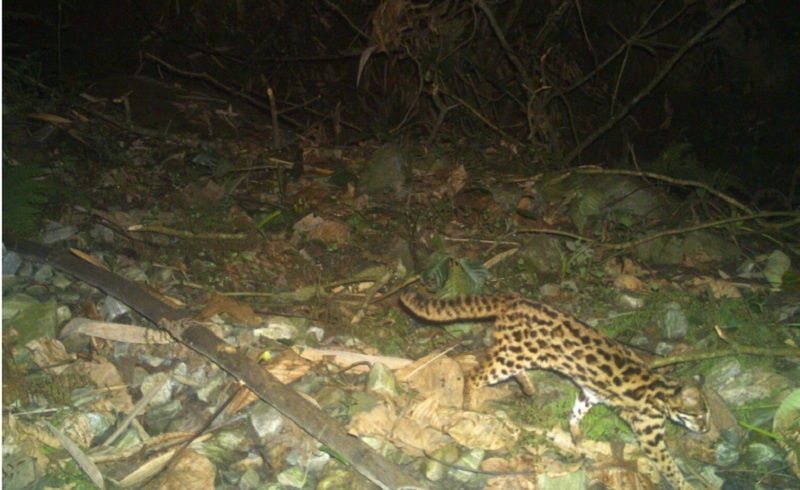Camera traps reveal Hidden cat world in Arunachal Pradesh
A new study offers glimpses into the habitat preferences, activity patterns and threats faced by the small cat population in the Mehao Wildlife Sanctuary (WLS) in Arunachal Pradesh using camera traps. These small cats were documented via camera traps for the first time in the sanctuary, in the Lower Dibang Valley of Arunachal Pradesh, as part of a study on mammalian species titles Site Occupancy of Select Mammals in the Tropical Forests of Eastern Himalayas.
Terrestrial mammals are a key component of tropical forest communities, representing their rich and functionally diverse components. However, they face significant threats worldwide, including hunting, habitat loss, and fragmentation. To protect these mammals, it is important to understand how these changes affect their communities.
Mehao WLS, established in 1980, is home to numerous wildlife species such as tigers, leopards, hoolock gibbons, tree shrews, wild dogs, and clouded leopards. The terrain is plain in the southern section and hilly in the northern sections, with the valleys being narrow around river courses.
There are numerous Idu Mishmi villages along the sanctuary’s periphery including Koronu, Injuno, Abango, Balek, Simari, and Tiwarigaon. The Idu Mishmi is a sub-tribe of the Mishmi group in Arunachal Pradesh and neighbouring Tibet. The other two groups include Digaru and Miju.
The Idu Mishmi community primarily lives in the Mishmi Hills, bordering Tibet. Their ancestral homes are spread throughout the districts of Dibang Valley and Lower Dibang Valley. They have a strong connection with the region’s flora and fauna. Strong taboos also exist among the Idu Mishmi, prohibiting the hunting of many wildlife species.
Small cats prefer dense, undisturbed forests
As part of the study, by Arif Ahmad and GV Gopi of the Wildlife Institute of India (WII), the researchers documented several instances of leopard cats and marbled cats, offering glimpses into their habitat preferences and activity patterns. Data suggests that these small cats have a strong preference for dense and undisturbed forests, highlighting the importance of preserving these habitats to support their populations.
“The rarity of these cats underscores the need for continued monitoring and targeted conservation strategies to ensure their protection in the challenging terrain of the Mehao Wildlife Sanctuary,” said Ahmad.

A leopard cat. In the Mehai WLS small cats co-habit with numerous species including tiger and leopard. The new study suggests that small cats have a preference for dense and undisturbed forests. Image courtesy of the Wildlife Institute of India.
Species such as clouded leopards and marbled cats were recorded, but observed infrequently, and the study attributes this to various ecological factors. “Their elusive and solitary nature, combined with nocturnal habits, inherently makes them challenging to detect,” the study says. “Additionally, anthropogenic pressures such as habitat fragmentation and human disturbance may further decrease their detectability and pose local threats to these species. Competition with other predators and prey availability could also influence their spatial distribution and activity patterns.”
It further adds that their presence in the sanctuary indicates a healthy ecosystem, as they are often regarded as indicators of pristine habitats. It is crucial to understand these ecological dynamics in order to implement effective conservation strategies to safeguard these elusive feline species in the sanctuary.
Challenges during the study
The study documented 27 mammals with 12 identified as threatened on the International Union for Conservation of Nature (IUCN) Red List. “We conducted the study between November 2017 and February 2018 to assess the status and distribution of mammalian species,” Ahmad said, while speaking to Mongabay India.
“Utilising systematic camera trapping, we gathered extensive data to analyse mammal populations. By employing single-season occupancy models, we evaluated various factors influencing the detection probability and spatial utilisation of these species within the landscape. Our study provides valuable insights into the habitat preferences and distribution patterns of mammals in Mehao WLS, contributing to more informed conservation efforts,” he said.
He added that fieldwork in the Mehao WLS presented numerous challenges owing to the elusive and nocturnal nature of many species, making visual encounters or sightings rare. Additionally, several species in the area could not be studied using standard photographic methods for capture-recapture estimation, as they lacked unique identifiable features.
“The monsoon season further complicates research; bridges often wash away, and frequent landslides impede access,” Ahmad added. “Incessant rain degrades droppings, scats, and pellets, limiting the effectiveness of conventional methods to monitor mammal abundance.”
During their research, heavy snowfall and rainfall rendered some camera units inaccessible in winter and pre-monsoon periods. Consequently, extensive fieldwork in the northern part of Mehao WLS was not feasible due to persistent inaccessibility. “These challenges highlight the difficulties in conducting comprehensive mammal surveys in such rugged and remote landscapes,” he said.
Small cats in Mehao WLS also face several threats. Ahmad stated that the major threat faced by small cat species found in the Mehao WLS is habitat loss and fragmentation owing to anthropogenic pressure. “The diverse topography, vegetation and climatic conditions of Mehao WLS make it an important landscape for all mammalian species,” he said. “However, human-induced land-use changes such as deforestation, agricultural expansion and infrastructure development can lead to habitat destruction and fragmentation, which significantly impacts the habitat suitability for small cat species”.
It is imperative to recognise the importance of microhabitats in managing and conserving mammalian species and to design species-specific conservation initiatives accordingly. He said that owing to the lack of supporting information on small cat species in Mehao WLS, conducting long-term studies is essential for better understanding and conservation planning.
The study also adds that harnessing the social taboos of the Idu Mishmi community can facilitate their engagement in community-based conservation projects. “Such initiatives are essential for mitigating the threats faced by small cat species and ensuring their long-term survival in Mehao WLS,” Ahmad said.
Ipra Mekola, an environmentalist, said that the taboo in the Idu Mishmi community about killing wild cats plays a big role in their conservation. Mekola is from the community himself. “We believe that if someone kills a tiger or other wild cats, then severe misfortune will happen at their household. So, our people do not kill these animals, more out of fear of the taboo than the law,” he explained.
Interestingly, while tigers were not caught in the camera traps installed by WII, their presence has often been felt in areas around Mehao. A forest official, on condition of anonymity, shares that although tigers couldn’t be trapped on the cameras, the forest department receives regular complaints from the residents of Tiwarigaon, a village near Mehao, about tigers killing their domestic cattle called mithun.“We have found tiger pug marks in those areas.”
This article originally appeared on Mongabay. Read the original article here.



